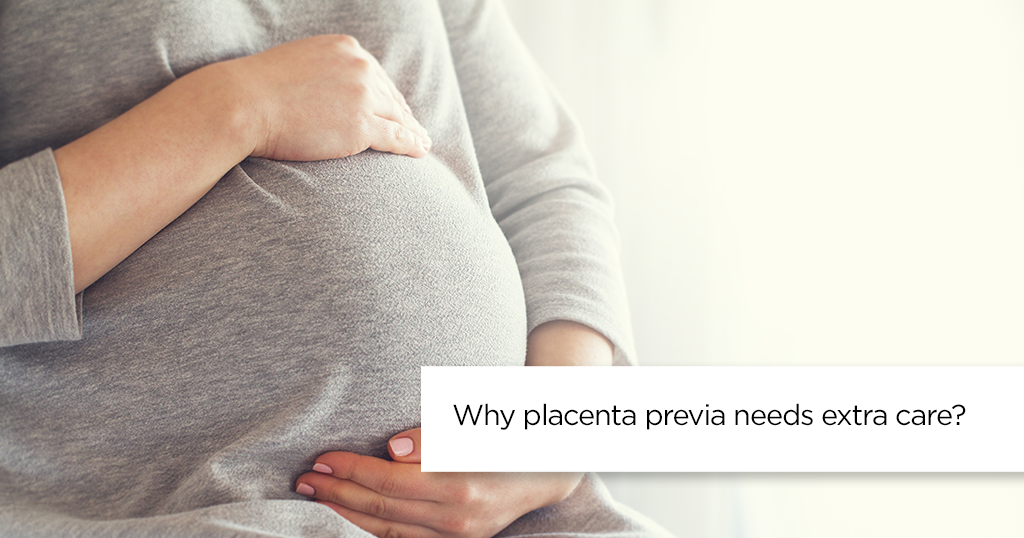Overview
The placenta is an organ which develops during pregnancy. It provides oxygen & nutrition to the baby and removes wastes & toxins. The placenta is attached to the baby via the umbilical cord. At most times, the placenta is attached at the top or side of the uterus, away from the cervix. Placenta previa takes place when the baby’s placenta ends up covering the mother’s cervix partially or totally.
What is Placenta Previa?
Also, known as low-lying placenta, Placenta Previa occurs if the placenta covers a part or the mother’s entire cervix during the last few months of pregnancy. Generally, as the pregnancy progresses, the placenta moves to the top of the womb allowing the cervix to be a clear path for delivery. The women who develop placenta previa undergo bleeding both before and during labor. This happens because during labor, the opening of the cervix can cause blood vessels which connect the placenta and the uterus to tear. This makes it risky for both the mother and the baby. So, to prevent this from happening, if the placenta previa does not resolve, you will need a C-section to deliver your baby.
Types of Placenta Previa
There are four main types of placenta previa, varying from minor to major. Each has its own type of treatment plan and determines whether the mother can have a normal delivery or will need a C-section. The types are:
- Partial: In this case, the placenta covers the opening of the cervix partially. Normal delivery is still possible.
- Low-lying: This type occurs in early to mid-pregnancy. Here, the placenta has a position at the edge of the cervix. There is a strong chance of going for a vaginal delivery.
- Marginal: Here, the placenta starts growing at the bottom of the uterus. The placenta will usually push against the cervix, but not exactly cover it. Though, any overlap during labor could result in bleeding, normal deliveries are generally safe.
- Major or complete: This is the most serious type of placenta previa. The placenta eventually covers the entire cervix and C-sections are the only way out.
Symptoms of Placenta Previa:
It is quite possible that you would not even know that you have placenta previa until and unless your doctor discovers it during a routine ultrasound. The main symptom of this condition is bright red vaginal bleeding without any pain during the second half of the pregnancy. The flow could range from being light or heavy accompanied by contractions. Other symptoms may include:
- Cramps or sharp pains
- Bleeding which starts, stops and then starts again days later
- Bleeding after intercourse
Causes of Placenta Previa
Though the exact cause of placenta previa is unknown, there are certain factors which supposedly increase the risk or trigger this condition. So, you may be more likely to get it if you:
- Have had a baby already
- Are of age 35 or older
- Had placenta previa during a past pregnancy
- Are pregnant with multiple fetuses like twins
- Have the baby in an unusual position
- Have a large placenta
- Have had previous surgeries involving the uterus, like dilation and curettage, uterine fibroids removal surgery etc.
- Have had a prior miscarriage
- Have habit of smoking
- Have an abnormally-shaped uterus
Treatment for Placenta Previa
Doctors will decide the treatment plan for your placenta previa depending on the amount of bleeding, the baby’s health status, how advanced the pregnancy is and the position of the placenta & the baby. The bleeding however is the doctor’s main concern. The treatments for different cases are as follows:
- Minimal to no bleeding: For cases of placenta previa where the mother experiences minimal or no bleeding, the doctor will advise enough bed rest. This implies resting as much as possible, and standing or sitting only when absolutely necessary. Doctors also suggest refraining from exercising and sex during this time. If more bleeding takes place during this phase, medical care should be sought as soon as possible.
- Heavy bleeding: In cases of placenta previa which involves heavy bleeding, the mother needs hospital bed rest. Depending on the amount of blood loss, she may require blood transfusions. Medicines are also given to prevent premature labor. In cases of such heavy bleeding, the doctor will want to do a C-section as soon as it is safe to deliver the baby – most likely after 36 weeks.
- Uncontrollable bleeding: For the cases of placenta previa which involve uncontrollable bleeding, an emergency cesarean delivery is the only thing that can be done.
Conclusion
Placenta previa is not to be ignored because of the dangers it can pose. If you are going to be a mother, or any loved one is, make sure that there is a lot of care taken. If there is any unusual bleeding at any course during the pregnancy, medical help should be sought immediately. Do not miss routine checks with your obstetrician. Take the requisite screening tests like ultrasound scans as advised by your doctor, help to detect this condition early and plan the treatment strategy for safe delivery.


















